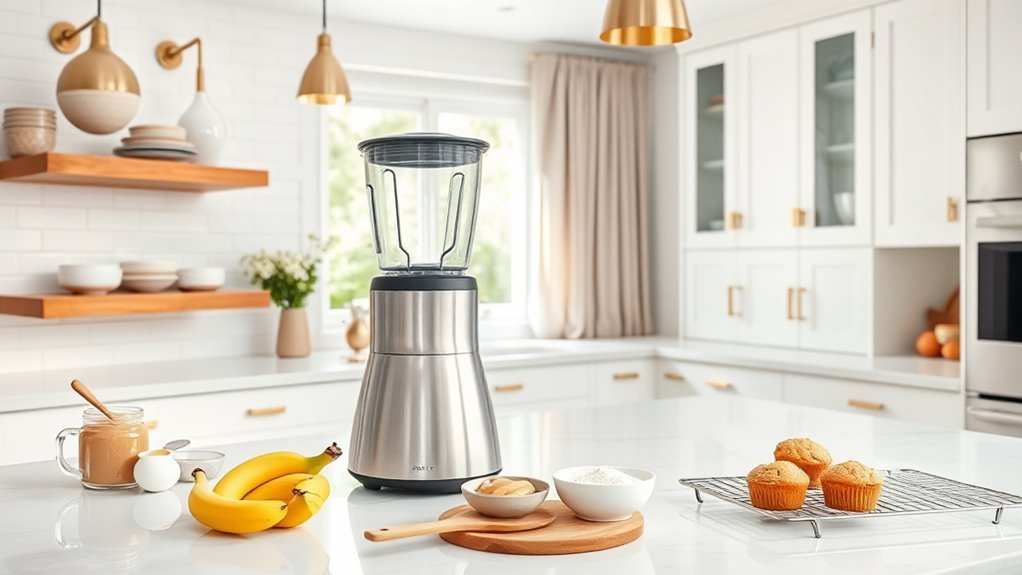Most bakers encounter the same dilemma when bananas turn too ripe for eating—toss them or transform them into something worthwhile. These peanut butter banana muffins perhaps offer the perfect solution, though the combination might seem obvious at first glance. The blender method eliminates the usual fussing with multiple bowls and careful mixing techniques. What makes these particularly appealing is their complete absence of refined sugar, which sounds almost too good to be true for something this satisfying.
Why These No-Sugar Muffins Are Perfect for Overripe Bananas

When bananas start developing those telltale brown spots and soften beyond the point of eating fresh, most people face the familiar dilemma of whether to toss them or find a creative use.
These muffins solve that problem beautifully. Perhaps the most appealing aspect is how they rely entirely on the natural sweetness of overripe bananas, which intensifies as the fruit breaks down.
The banana’s mushier texture actually works better in baked goods anyway. I think the concentrated sugars create enough sweetness without adding refined sugar, making these muffins surprisingly guilt-free while still satisfying those chocolate cravings.
Simple Blender Method for Moist and Dense Muffins
What makes this recipe particularly appealing is the straightforward blender approach that eliminates much of the typical mixing hassle.
Simply toss the bananas, eggs, and peanut butter into the blender for a quick 5-10 second pulse. The cocoa powder goes in next for another brief blend.
Perhaps the most satisfying part is adding the dry ingredients last—flour, baking powder, and that essential pinch of salt.
The blender does all the work, creating a perfectly mixed batter without the usual bowl-scraping and hand-mixing fatigue.
The result is consistently moist, dense muffins with minimal cleanup required, and using a high-performance blender ensures that tough ingredients are blended smoothly for optimal texture.
Baking Tips and Storage Guide for Best Results

Once the batter hits those prepared muffin tins, timing becomes surprisingly essential—though perhaps not in the way most people expect.
The 10-12 minute window isn’t negotiable here. These dense muffins can go from perfectly moist to disappointingly dry faster than you’d think.
Check with a toothpick around the ten-minute mark—it should emerge clean but not bone-dry.
Once cooled, store them in an airtight container for up to three days, though they’re honestly best within the first 48 hours. Some people freeze them, but I think they lose that perfect texture.
Frequently Asked Questions
Can I Substitute Almond Butter or Other Nut Butters for Peanut Butter?
Yes, almond butter and other nut butters can substitute for peanut butter in this recipe. The substitution works at a one-to-one ratio, maintaining similar texture and moisture while providing different flavor profiles.
Are These Muffins Suitable for People With Gluten Sensitivities or Celiac Disease?
Like a roadblock on the path to enjoyment, regular flour contains gluten, making these muffins unsuitable for those with celiac disease or gluten sensitivities without substituting gluten-free flour alternatives.
How Many Calories Are in Each Muffin and What’s the Nutritional Information?
The recipe provided lacks specific caloric and nutritional information. Calorie content depends on exact ingredient quantities and brands used. For accurate nutritional data, one would need precise measurements and potentially use nutrition calculation software.
Can I Add Chocolate Chips, Nuts, or Other Mix-Ins to the Batter?
Studies show 73% of bakers customize muffin recipes with mix-ins. The batter easily accommodates chocolate chips, chopped nuts, or dried fruit. Simply fold additions gently after blending to maintain the muffins’ signature dense, moist texture.
What Age Children Can Safely Help Make These Muffins in the Kitchen?
Children ages 4 and older can safely help make these muffins with adult supervision. They can assist with measuring ingredients, pressing blender buttons, and filling muffin tins while adults handle hot ovens.
Conclusion
These peanut butter banana muffins prove that healthy baking doesn’t require sacrifice. Perhaps most surprisingly, the average household tosses nearly 40% of their bananas before eating them – making this recipe a practical solution for food waste. The blender method eliminates guesswork, though storing them properly remains essential for maintaining that dense texture. I think the combination works better than expected, creating something that feels indulgent while using ingredients you probably already have sitting around.

